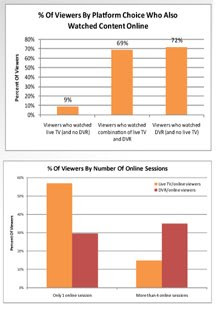
According to a new study by Integrated Media Measurement Inc. (IMMI), a consumer behavior research firm, audiences are spending more time multitasking while watching broadcast programs than ever before.
Specifically, the study found that TV watchers spend an average of 9.3 percent of their time online while simultaneously watching television. Among viewers watching broadcast TV, 11 percent also are surfing the Web. For cable viewers, it’s 8.2 percent.
"During the past year, there has been much debate about the perils of making television programming available via the Internet," said Amanda Welsh, head of research for Integrated Media Measurement Inc. “While some have speculated or feared that online accessibility would cannibalize television audiences, our data shows that the affinity of DVR users to view television episodes online offers advertisers new opportunities to recapture a desirable audience that had been slipping away."
Of the people who watched primetime programming both online and on a DVR during the month, 35 percent watched four or more episodes online, compared with 15 percent for people who watched prime time programming both online and on live television. Of the people who watched prime time programming both online and on a DVR, 30 percent went online only once, compared with 57 percent for people who watched prime time programming both online and on live television.
Previously, IMMI had found 50 percent of online viewing are audience members watching episodes they missed on television. They are either filling in an episode online when they had already seen the other episodes around it on TV (18.7%), or they are catching up on an episode online after seeing the subsequent episodes on TV (31.3%). The other 50% are apparently viewers using the Internet to check out shows, replacing the channel flipping or sampling they might have done on the television in the past.
Integration Over Traditional Thinking Is Key
The bottom line is that advertisers cannot continue to afford a singular mindset as if to choose television over online marketing. As the IMMI study suggests, consumers do not distinguish between delivery systems.
They simply want to watch their programs. And we're not the only ones to think so.
“To effectively utilize digital media, and promote its integration with traditional media, marketers and advertisers must overcome the two obstacles that continuously arise: education and measurement,” said Bob Liodice, president and CEO of the Association of National Advertisers told TV Week. “Only once the industry takes steps to become savvy will integrated marketers be able to fully embrace all that advertising today can offer a brand.”
We're seeing it play out exactly like this with one of the projects we're currently engaged in. While more traditional thinkers on the team are quick to dismiss the greater impact of other team members (both with product and with exposure), the 360-degree view demonstrates the audience does not distinguish between entertainment assets such as soundtrack and film nor do they distinguish between traditional media and online engagement. Rather, the audience sees various elements as different contact points working toward each other.
In this case, as the online audience learns about exposure in traditional media, they rush to review the content and set the tone for non-engaged reader feedback left on the traditional articles. In essence, they are both engaged promoters and media consumers. No one can really separate the two as traditional marketers/public relations practitioners and social media experts tend to do nor as advertising and public relations or print, broadcast, and online proponents continue to do. Nor even as broadcast/print or online programmers/online continue to do for that matter.
Integrated communication, working seamlessly together on assets or promotion, will deliver the best return on investment over the long term, which is best described about 90 days. That's right. Ninety days is long term, and online, even seven seems like an eternity.
Some Related Ideas
• Is social media a revolution in local government communications? by Simon Wakeman
• 365 is the new 360 by Tom Beckman
• Beginning 2009: The year of communication from Copywrite, Ink.
















0 comments:
Post a Comment